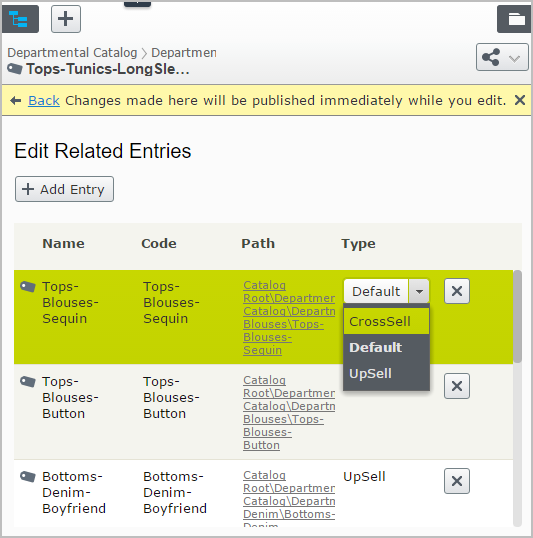This topic describes how to work with related entries (associations), and how to create custom relationship types in Episerver Commerce.
How it works
Related entries are represented by the EPiServer.Commerce.Catalog.Linking.Association class and administered using the EPiServer.Commerce.Catalog.Linking.ILinksRepository service.
The Target property of the Association contains the ContentReference of the related entry. The class also has a EPiServer.Commerce.Catalog.Linking.AssociationGroup (defined by its Name property) describing a grouping of several related entries, and a EPiServer.Commerce.Catalog.Linking.AssociationType (defined by its Id property) describing the type of the relation.
These three properties, together with the Source ContentReference (the item that has the related item) together uniquely define a related item, that is, there can not be two Association objects with all these values equal.
Getting related entries for an entry
By calling the GetAssociations method of ILinksRepository with the ContentReference of an entry, you get all the related entries. The related entries are returned as Association instances:
C#
public IEnumerable<Association> ListAssociations(ContentReference referenceToEntry)
{
var linksRepository = ServiceLocator.Current.GetInstance<ILinksRepository>();
var associations = linksRepository.GetAssociations(referenceToEntry);
return associations;
}
Adding a related entry to an entry
Use the UpdateAssociations method or UpdateAssociation extension method of ILinksRepository to add new Association objects to describe a new relation to an entry. The new entry must have a Target ContentReference, a Source ContentReference, a AssociationGroup and a AssociationType. The AssociationGroup class has a DefaultName property you can use as name of the group, and the AssociationType class has a DefaultId property you can use as id of the type.
C#
public void AddAssociation(ContentReference referenceToEntry, ContentReference referenceToRelatedEntry)
{
var linksRepository = ServiceLocator.Current.GetInstance<ILinksRepository>();
var newAssociation = new Association
{
Group = new AssociationGroup
{
Name = "CrossSell",
Description = "",
SortOrder = 100
},
SortOrder = 100,
Source = referenceToEntry,
Target = referenceToRelatedEntry,
Type = new AssociationType
{
Id = AssociationType.DefaultTypeId,
Description = ""
}
};
linksRepository.UpdateAssociation(newAssociation);
}
Removing a related entry from an entry
To remove a related item, call the RemoveAssociations method or the RemoveAssociation extension method of ILinksRepository with a Association object matching an existing related item. You can construct a matching object, or use GetAssociations to get the existing Associations, to filter out the object you want to remove and pass it to RemoveAssociation.
C#
public void RemoveAssociation(ContentReference referenceToEntry, ContentReference referenceToRelatedEntry)
{
var linksRepository = ServiceLocator.Current.GetInstance<ILinksRepository>();
// Define an association matching the one to remove, or use
// GetAssociations to find the one you want to remove and pass that to
// RemoveAssociation
var relationToRemove = new Association
{
// Group with name is required to match the correct association
Group = new AssociationGroup
{
Name = "CrossSell"
},
// Source is required here to match the correct association
Source = referenceToEntry,
Target = referenceToRelatedEntry,
// Type with id is required to match the correct association
Type = new AssociationType
{
Id = AssociationType.DefaultTypeId
}
};
// Removes matching Association, or no action if no match exists
linksRepository.RemoveAssociation(relationToRemove);
}
Adding custom association group definition
When marketers are editing relations for entries, they can select the type of relation from a predefined list of association groups. As a developer, you can add items to that list to make your custom association group defintions available in the drop-down.

Populate the list by adding the code as illustrated in the example below, and call that from your InitializationModule.
C#
public static void AddAssociationGroup()
{
// Add predefined selections CrossSell
// If they already exist nothing will be added
var associationDefinitionRepository =
ServiceLocator.Current.GetInstance<GroupDefinitionRepository<AssociationGroupDefinition>>();
associationDefinitionRepository.Add(new AssociationGroupDefinition { Name = "CrossSell" });
}
Do you find this information helpful? Please log in to provide feedback.

